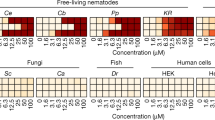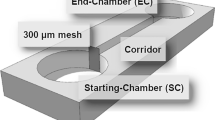Abstract
The phylum Nematoda occupies a huge range of ecological niches, from free-living microbivores to human parasites. We analyzed the genomic biology of the phylum using 265,494 expressed-sequence tag sequences, corresponding to 93,645 putative genes, from 30 species, including 28 parasites. From 35% to 70% of each species' genes had significant similarity to proteins from the model nematode Caenorhabditis elegans. More than half of the putative genes were unique to the phylum, and 23% were unique to the species from which they were derived. We have not yet come close to exhausting the genomic diversity of the phylum. We identified more than 2,600 different known protein domains, some of which had differential abundances between major taxonomic groups of nematodes. We also defined 4,228 nematode-specific protein families from nematode-restricted genes: this class of genes probably underpins species- and higher-level taxonomic disparity. Nematode-specific families are particularly interesting as drug and vaccine targets.
This is a preview of subscription content, access via your institution
Access options
Subscribe to this journal
Receive 12 print issues and online access
$259.00 per year
only $21.58 per issue
Buy this article
- Purchase on SpringerLink
- Instant access to full article PDF
Prices may be subject to local taxes which are calculated during checkout






Similar content being viewed by others
References
De Ley, P. & Blaxter, M.L. Systematic position and phylogeny. in The Biology of Nematodes (ed. Lee, D.) 1–30 (Taylor & Francis, London, 2002).
Platt, H.M. Foreword. in The Phylogenetic Systematics of Free-living Nematodes (Lorenzen, S.) (The Ray Society, London, 1994).
Lambshead, P.J.D. Recent developments in marine benthic biodiversity research. Oceanis 19, 5–24 (1993).
Blaxter, M.L. et al. A molecular evolutionary framework for the phylum Nematoda. Nature 392, 71–75 (1998).
Chan, M.-S. The global burden of intestinal nematode infections - fifty years on. Parasitol. Today 13, 438–443 (1997).
Barker, K.R., Hussey, R.S. & Krusberg, L.R. Plant and Soil Nematodes: Societal Impact and Focus on the Future (Committee on National Needs and Priorities in Nematology, Society of Nematologists, Marceline, Missouri, USA, 1994).
The C. elegans Genome Sequencing Consortium. Genome sequence of the nematode C. elegans: a platform for investigating biology. Science 282, 2012–2018 (1998).
Wood, W.B. (ed.) The Nematode Caenorhabditis elegans 667 (Cold Spring Harbor Laboratory Press, New York, 1988).
Riddle, D. Blumenthal, T., Meyer, B. & Priess, J. (eds.) C. elegans II 1222 (Cold Spring Harbor Laboratory Press, New York, 1997).
Stein, L.D. et al. The genome sequence of Caenorhabditis briggsae: A platform for comparative genomics. PLoS Biol. 1, E45 (2003).
Parkinson, J., Mitreva, M., Hall, N., Blaxter, M. & McCarter, J.P. 400000 nematode ESTs on the Net. Trends Parasitol. 19, 283–286 (2003).
Boguski, M.S., Lowe, T.M. & Tolstoshev, C.M. dbEST - database for “expressed sequence tags”. Nat. Genet. 4, 332–333 (1993).
Lizotte-Waniewski, M. et al. Identification of potential vaccine and drug target candidates by expressed sequence tag analysis and immunoscreening of Onchocerca volvulus larval cDNA libraries. Infect. Immun. 68, 3491–3501 (2000).
Tetteh, K.K., Loukas, A., Tripp, C. & Maizels, R.M. Identification of abundantly expressed novel and conserved genes from the infective larval stage of Toxocara canis by an expressed sequence tag strategy. Infect. Immun. 67, 4771–4779 (1999).
Daub, J., Loukas, A., Pritchard, D.I. & Blaxter, M. A survey of genes expressed in adults of the human hookworm, Necator americanus. Parasitology 120, 171–184 (2000).
Blaxter, M.L. et al. Genes expressed in Brugia malayi infective third stage larvae. Mol. Biochem. Parasitol. 77, 77–96 (1996).
McCarter, J.P. et al. Analysis and functional classification of transcripts from the nematode Meloidogyne incognita. Genome Biol. 4, R26 (2003).
Mitreva, M. et al. Comparative genomics of gene expression in the parasitic and free-living nematodes Strongyloides stercoralis and Caenorhabditis elegans. Genome Res. 14, 209–220 (2004).
Mitreva, M. et al. Gene discovery in the adenophorean nematode Trichinella spiralis: an analysis of transcription from three life cycle stages. Mol. Biochem. Parasitol. 137, 277–291 (2004).
Harcus, Y.M. et al. Signal sequence analysis of expressed sequence tags from the nematode Nippostrongylus brasiliensis and the evolution of secreted proteins in parasites. Genome Biol. 5, R39 (2004).
Whitton, C. et al. A genome sequence survey of the filarial nematode Brugia malayi: repeats, gene discovery, and comparative genomics. Mol. Biochem. Parasitol. 137, 215–227 (2004).
Parkinson, J., Whitton, C., Schmid, R., Thomson, M. & Blaxter, M. NEMBASE: a resource for parasitic nematode ESTs. Nucleic Acids Res. 32, D427–D430 (2004).
Wylie, T. et al. Nematode.net: a tool for navigating sequences from parasitic and free-living nematodes. Nucleic Acids Res. 32, D423–D426 (2004).
Tatusov, R.L. et al. The COG database: new developments in phylogenetic classification of proteins from complete genomes. Nucleic Acids Res. 29, 22–28 (2001).
Blaxter, M.L. Caenorhabditis elegans is a nematode. Science 282, 2041–2046 (1998).
Wang, D.Y., Kumar, S. & Hedges, S.B. Divergence time estimates for the early history of animal phyla and the origin of plants, animals and fungi. Proc. R. Soc. Lond. B Biol. Sci. 266, 163–171 (1999).
Reboul, J. et al. C. elegans ORFeome version 1.1: experimental verification of the genome annotation and resource for proteome-scale protein expression. Nat. Genet. 34, 35–41 (2003).
Kamath, R.S. et al. Systematic functional analysis of the Caenorhabditis elegans genome using RNAi. Nature 421, 231–237 (2003).
Barnes, T.M., Kohara, Y., Coulson, A. & Hekimi, S. Meiotic recombination, noncoding DNA and genomic organization in Caenorhabditis elegans. Genetics 141, 159–179 (1995).
Simmer, F. et al. Genome-wide RNAi of C. elegans using the hypersensitive rrf-3 strain reveals novel gene functions. PLoS Biol. 1, E12 (2003).
Gregory, W.F. & Parkinson, J. Caenorhabditis elegans – applications to nematode genomics. Comp. Funct. Genomics 4, 194–202 (2003).
Parkinson, J. & Blaxter, M.L. SimiTri - visualising similarity relationships for large groups of sequences. Bioinformatics 19, 390–395 (2002).
Aboobaker, A.A. & Blaxter, M.L. Hox gene loss during dynamic evolution of the nematode cluster. Curr. Biol. 13, 37–40 (2003).
Roy, P.J., Stuart, J.M., Lund, J. & Kim, S.K. Chromosomal clustering of muscle-expressed genes in Caenorhabditis elegans. Nature 418, 975–979 (2002).
Enright, A.J., Van Dongen, S. & Ouzounis, C.A. An efficient algorithm for large-scale detection of protein families. Nucleic Acids Res. 30, 1575–1584 (2002).
Zdobnov, E.M. & Apweiler, R. InterProScan - an integration platform for the signature-recognition methods in InterPro. Bioinformatics 17, 847–848 (2001).
Hutter, H. et al. Conservation and novelty in the evolution of cell adhesion and extracellular matrix genes. Science 287, 989–994 (2000).
Johnstone, I.L. & Barry, J.D. Temporal reiteration of a precise gene expression pattern during nematode development. EMBO J. 15, 3633–3639 (1996).
Hawdon, J.M., Jones, B.F., Hoffman, D.R. & Hotez, P.J. Cloning and characterization of Ancylostoma-secreted protein. A novel protein associated with the transition to parasitism by infective hookworm larvae. J. Biol. Chem. 271, 6672–6678 (1996).
The Gene Ontology Consortium. Creating the gene ontology resource: design and implementation. Genome Res 11, 1425–1433 (2001).
Blaxter, M. Nematoda: Genes, genomes and the evolution of parasitism. Adv. Parasitol. 54, 102–195 (2003).
Kanehisa, M., Goto, S., Kawashima, S., Okuno, Y. & Hattori, M. The KEGG resource for deciphering the genome. Nucleic Acids Res. 32, D277–D280 (2004).
Ghedin, E., Wang, S., Foster, J.M. & Slatko, B.E. First sequenced genome of a parasitic nematode. Trends Parasitol. 20, 151–153 (2004).
Williams, S.A. et al. The filarial genome project: analysis of the nuclear, mitochondrial and endosymbiont genomes of Brugia malayi. Int. J. Parasitol. 30, 411–419 (2000).
Hillier, L.D. et al. Generation and analysis of 280,000 human expressed sequence tags. Genome Res. 6, 807–828 (1996).
Whitton, C., Daub, J., Thompson, M. & Blaxter, M. Expressed sequence tags: medium throughput protocols. in Parasite Genomics (ed. Melville, S.E.) (Humana, New York, in the press).
Parkinson, J. et al. PartiGene - constructing partial genomes. Bioinformatics 20, 1398–1404 (2004).
Parkinson, J., Guiliano, D. & Blaxter, M. Making sense of EST sequences by CLOBBing them. BMC Bioinf. 3, 31 (2002).
Altschul, S.F. et al. Gapped BLAST and PSI-BLAST: a new generation of protein database search programs. Nucleic Acids Res. 25, 3389–3402 (1997).
Acknowledgements
We thank all our nematology and parasitology colleagues for supplying materials (see Supplementary Methods online) and for their enthusiasm for this project and A. Anthony, J. Wasmuth and A. Hedley for trace2dbest, PartiGene and prot4EST software. The UK arm of the project was funded by the Wellcome Trust, and the US arm by the National Institutes of Health (National Institute of Allergy and Infectious Diseases). J.P.M. was supported by a Helen Hay Whitney/Merck fellowship. Sequencing at The Wellcome Trust Sanger Institute was carried out by C. Churcher, T. Chillingworth, P. Cummings, Z. Hance, K. Jagels, S. Moule and S. Whitehead. Most of the computational analyses were done using facilities at the Center for Computational Biology, Hospital for Sick Children, Toronto.
Author information
Authors and Affiliations
Corresponding author
Ethics declarations
Competing interests
J.P.M. is an employee of and equity holder in Divergence, Inc.
Supplementary information
Supplementary Fig. 1
Novel nematode-specific domains showing high sequence conservation. (PDF 33 kb)
Supplementary Table 1
Polypeptide and domain predictions for nematode species. (PDF 9 kb)
Supplementary Table 2
Most abundant InterPro domains in the nematode partial genomes. (PDF 9 kb)
Supplementary Table 3
Representation of partial genomes in KEGG metabolic pathways. (PDF 9 kb)
Rights and permissions
About this article
Cite this article
Parkinson, J., Mitreva, M., Whitton, C. et al. A transcriptomic analysis of the phylum Nematoda. Nat Genet 36, 1259–1267 (2004). https://doi.org/10.1038/ng1472
Received:
Accepted:
Published:
Issue date:
DOI: https://doi.org/10.1038/ng1472
This article is cited by
-
Nuclear genome annotation of wheel animals and thorny-headed worms: inferences about the last common ancestor of Syndermata (Rotifera s.l.)
Hydrobiologia (2023)
-
The production of excretory-secretory molecules from Heligmosomoides polygyrus bakeri fourth stage larvae varies between mixed and single sex cultures
Parasites & Vectors (2021)
-
Co-evolution based machine-learning for predicting functional interactions between human genes
Nature Communications (2021)
-
Improved phylogenomic sampling of free-living nematodes enhances resolution of higher-level nematode phylogeny
BMC Evolutionary Biology (2019)
-
Comprehensive Evolutionary Analysis of the Major RNA-Induced Silencing Complex Members
Scientific Reports (2018)



